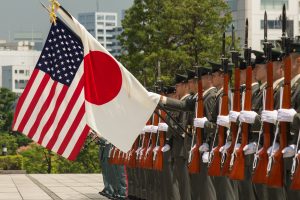By Ankit Panda
Are American ground-launched missiles realistically deployable in Japan? And if so, what kinds of missiles and under what conditions? These are the questions that have quickly risen to the top of strategic and bureaucratic debates in Japan – a response to the quick demise of the INF Treaty under the Trump administration. The treaty’s end opens up new conventional deterrence options for consideration by the U.S.-Japan alliance. While the introduction of missiles is unlikely to occur anytime soon for the simple fact that post-INF American missiles don’t exist just yet, Tokyo is fully expecting that Washington will open consultations on the matter as early as the end of 2019 or in early 2020.
On August 2, the United States effectuated its withdrawal from the 1987 Intermediate-Range Nuclear Forces (INF) Treaty.
While the primary reason for the American withdrawal from the treaty may have been the Russian violation, China was also a factor. Over the 32 years that the INF Treaty bound the United States and Russia (with the exception of the one violating missile type), China emerged as a missile power in its own right. U.S. Indo-Pacific Command, for instance, has long seen the value of the INF Treaty in diminished terms owing to the growing missile challenge from China, which was never bound by the treaty.
In simple terms, the end of the INF Treaty allows for the United States to bring back into its arsenal a class of weaponry that it was prohibited from possessing and deploying for 32 years. Per the language in the now-defunct treaty, short-range missiles were defined as systems with a range of 500 to 1,000 kilometers, while intermediate-range missiles were defined as falling in the 1,000 to 5,500 kilometer range. Even as the “N” in INF stands for nuclear, the treaty barred all missiles based on the ground within those ranges – nuclear and conventional. After it was signed and ratified, the treaty resulted in the verified elimination of an entire class of weaponry between the two Cold War superpowers – the first arms control treaty to do so. In the post-INF context, all new capabilities under consideration for now are strictly designed to be conventional only.
For Japan, the post-INF environment in Asia presents a welcome opportunity for augmenting deterrence by exploring the introduction of new American capabilities to the Pacific theater, but also raises concerns about a deteriorating security dilemma with China. Beijing’s arsenal of 2,000-plus ballistic and cruise missiles in the INF-proscribed ranges means, for instance, that any American capabilities would not be immediately part of an arms race, but would contribute to closing what Japanese observers see as a “missile gap“ in today’s East Asian security environment. But some Japanese officials who spoke to The Diplomat are concerned about whether American missile deployments are the right way to cope with the missile challenge from China, seeing the possibility of worsening the security dilemma in East Asia.

No comments:
Post a Comment